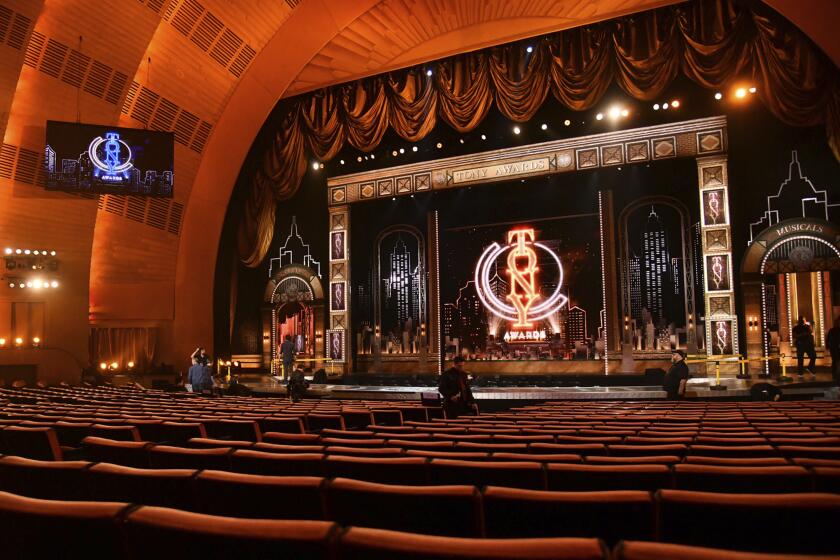ART / Cathy Curtis : Reading All About It Makes ‘The Lagoon Cycle’ a Chore to Appreciate
- Share via
“Performance, text, image, interactions--we’re involved in everything,” asserts Helen Mayer Harrison, the matronly, confident-looking woman whose work is on display at the Laguna Art Museum.
“I don’t know about that,” interrupts Newton Harrison, her bearded husband. “I’m not involved in everything. I’d like to say we’re involved in almost everything.”
Helen Harrison laughs. The couple (she is an educator; he is a sculptor and painter) have spent the last 18 years collaborating on projects at the crossroads of science, environmental studies and art. What they do is as close to “everything” as seems humanly possible.
They work in the real world--studying harmful land uses and ways of preserving the ecosystem, experimenting with methods to generate a cheap food supply, creating a greenbelt in San Jose and a promenade in Baltimore. And they translate their research and opinions into performances, site-specific works and permanent documents that can be shown in museum settings.
In Laguna Beach, they are showing their “Lagoon Cycle,” a seven-part artist’s book that has been unbound and mounted on the gallery walls. It documents the wide repercussions and influences of their 12-year experimentation with an edible crab that breeds in a lagoon in Sri Lanka.
A reader finds Newton and Helen assuming the respective roles of “Lagoonmaker” and “Witness” to hash out their ideas in metaphor-laced dialogues. Often, other characters intrude.
Early on, a Sri Lankan talks about how the richly stocked lagoons in his country are being depleted by foreign fishing fleets while modernization of the dams and reservoirs is impoverishing the people and ruining the land’s ecology.
Other Sri Lankans--shopkeeper, priest, taxi driver, actor, doctor, student, water department official, tourist guide--add their own two cents about the country’s lingering traditions and recent changes. The truth of the matter is elusive, seen through a kaleidoscope of personal interpretations.
Gradually, the reader begins to absorb the texture of the Harrisons’ experience, and realizes that a topic with implications as vast as ecology necessarily impinges on such far-flung considerations as religion, history, economics, legend, habit and symbolism.
Based on what they learned in Sri Lanka, the Harrisons write of constructing a tank, figure out how to simulate conditions in the lagoon, acquire grant support for the project and even come to empathize with their captive crustaceans. Other people--an investor, a scientist, a newspaper publisher, an accountant and a political radical--evince interest in the experiment, but each has a personal ax to grind.
Eventually, the Harrisons propose to create an estuarial lagoon in California’s Colorado Desert fed by the briny Salton Sea and the fresh-water All-American Canal, and they find themselves looking at maps of the coastal area in strange new ways. To the Lagoonmaker, the Salton Sea becomes “a diseased bladder,” and he imagines himself “as a surgeon, inserting a catheter and generating an artificial urethra.”
The Witness replies that the ocean then becomes a septic tank. If the Salton Sea is flushed out by making it a lagoon, that means 360 square miles of contaminated, too-salty water will be transferred to the Pacific. And who will flush that out?
The latter stages of “The Lagoon Cycle” become increasingly metaphorical and speculative, climaxing in a great melodic crescendo of statements about a global phenomenon: the persistent rise in the water level that one day will force the populations of the world to “withdraw.”
Woven through the pages and pages of narrative are meticulous maps, diagrams, colored drawings and hand-colored photographs. But the essential meaning, energy and poetic reverberation of the piece comes largely from the power of the written word. And therein lies a problem.
It is true that many works of contemporary art convey their message only with exceedingly careful observation and a great deal of thought on the part of the viewer. But “The Lagoon Cycle” exhibit demands that viewers endure eyestrain and fatigue while trying to read a dense, handwritten manuscript that snakes around the gallery walls. And that’s a bit much.
Although the light-colored script helps to give the dialogue a personal, individualistic character, a typeface would have been much easier on the eyes. But even with a clearer text, this is a book that, like any other, begs to be handled by a comfortably seated reader.
A closed copy of the original limited-edition book, positioned under a dramatic light and chained off from viewers’ grubby hands, is available for the faithful to gaze upon in a separate gallery--an absurdly pseudo-dramatic installation that doesn’t jibe with what the Harrisons are all about.
The full text is available in the paperback catalogue of the exhibition. Still, the optimum (though undeniably pricey) solution to exhibiting “The Lagoon Cycle” in museums might be to translate the text, maps and charts into an interactive computer program and show the drawings and photographs separately.
In the meantime, the exhibit includes an excellent short video introduction to the Harrisons and their work, created at the Long Beach Museum of Art Video Annex by Joe Leonardi and Cathleen Kane with the support of the Fellows of Contemporary Art.
Despite the exhibit’s mechanical problems, the project itself is extraordinary--rather like a lively mini-university dispensing information, analysis, doubt, vision and poetic discourse. Not to mention a cogent and timely warning of ecological crisis.
“The Lagoon Cycle” continues through March 12 at the Laguna Art Museum, 307 Cliff Drive, Laguna Beach. Hours: 11 a.m. to 5 p.m. Tuesdays through Sundays. Admission: $2. Information: (714) 494-6531.
More to Read
The biggest entertainment stories
Get our big stories about Hollywood, film, television, music, arts, culture and more right in your inbox as soon as they publish.
You may occasionally receive promotional content from the Los Angeles Times.










